Clearwater Historic Lodge, Moose Viewing Platform, Bearskin Lodge, Laurentian Divide Overlook, Chik-Wauk Museum, Trail’s End Café, Gunflint Trail Lodge
Day 6: On which I do not view moose at the moose viewing platform but do enjoy a serious ice cream cookie, lift the load of a voyageur, and reach the end of the trail
August 6, 2014
After a hearty breakfast prepared and served by the daughter of one of the original owners of Clearwater Historic Lodge and deciding to delay a visit to Honeymoon Bluff until sunset (if time and my energy allowed), we backtracked toward Grand Marais to find the promised moose viewing platform. We couldn’t remember how close it was to the Grand Marais beginning of the trail, and, if I recall correctly, we stopped short of it and drove back and forth a few times without finding it again. Not only are Minnesota moose elusive, but so is the moose viewing platform. Finally, we spotted the sign we’d seen so clearly the night before.
The trail was easy, and the mosquitoes were strangely intermittent — they weren’t always more abundant in the shady parts, as I would have expected. On the way we saw many wildflowers and mushrooms. Northern Minnesota is a macro photographer’s fantasy — for as long as you can tolerate standing still among the biting insects.
At last we made it to the moose viewing platform, which we shared with a family. Based on previous visits and what they’d been told, they didn’t expect to see any moose, but like us they seemed to have that spirit of, “Keep trying just in case!” By this time, it was past 11 a.m., and any moose in the area had probably finished breakfast hours earlier before any of us had woken up — that is, if there are any moose in the area. In Ely, we’d read that the Minnesota moose population has been decimated due to a surge in winter ticks.
Of course, I needed a visit to the facilities — any facilities. There are no rest stops on the Gunflint Trail. We found Bearskin Lodge and Resort, lured in by the promise of ice cream sandwiches. We found a pleasant owner and great gift shop in addition to the facilities. The ice cream sandwiches proved to be generous slabs of ice cream tucked between two giant chocolate chip cookies. Eating them gave us an excuse to hang out on the deck overlooking Bearskin Lake and watch the hummingbirds. Undoubtedly, in just a few moments we negated any health benefits provided by the morning’s moose viewing walk.
After tearing ourselves away from this comfortable spot, we stopped at a Laurentian Divide overlook, where J. recognized someone he’d seen earlier in the trip. It’s a small world . . .
As we headed west, we noticed acre after acre of scorched forest, with thousands of spiky, blackened skeletons of trees seeming to reach for the blue heavens. I learned later that 75,000 acres and numerous structures burned during what is called the Ham Lake Fire, which started when a camper started a paper and trash fire on a windy day that quickly got out of control. Doesn’t anyone listen to Smokey Bear? (Beyond the fire, the story is tragic, with the camper ultimately committing suicide.)
Close to the end of the trail is the Chik-Wauk Museum and Nature Center, which is focused on the history of the voyageurs. I managed to heft two voyageur packs using my back (after figuring out what was wrong about my first couple of attempts), but couldn’t have supported them for more than a nanosecond or carried them. Not surprisingly, many voyageurs lived short lives, and many are believed to have died from hernias. With the heavy loads, mosquitoes, long hours spent rowing and carrying everything over portages, and primitive conditions, this would not have been the life for me. It sounds more like hard labor punishment.
Behind the Chik-Wauk Museum I found a very short trail that lead to a little scenic overlook and a quick photo opportunity.
J. wanted to make sure he made it to the end of the Gunflint Trail, where we found Way of the Wilderness Canoe Outfitters and, more important, Trail’s End Café (by now we were both hungry). I expected to find the usual décor related to canoeing, kayaking, fishing, snowshoeing, etc. The last thing I expected to see was the array of Chicago sports memorabilia everywhere. We learned that the elderly owner (who returned with supplies before we left) had come here from Chicago decades earlier. He’d kept up with Chicago sports — there was as much or more memorabilia at Trail’s End as at a Chicago sports bar. For a moment, it felt like there was no escaping the city.
Having reached the end of the line, we backtracked and came upon a woman walking next to the road and looking into the trees. She said she’d spotted a baby black bear, but by the time we’d gotten situated there was nothing to see. We gave her a ride to the museum area. I never figured out where she was headed or how she was going to get there.
Eastward bound, once again I needed to use the facilities. This time, we stopped at Gunflint Lodge, which is a big, busy place at dinner and has wonderful views.
By this time, I was pretty sure I couldn’t handle the walk to Honeymoon Bluff, as much as I wanted to see it at sunset. J. proposed getting a canoe at Clearwater Historic Lodge. I fought the idea for a long time, partly because it’s difficult and embarrassing for me to get into and out of a canoe, and partly because I can’t swim (and he’s not a strong swimmer). The more I thought about it, however, the sillier it seemed not to do the one thing that folks go to the Boundary Waters for, even if we did it in a very limited way (my idea was to go a hundred yards out at most). J. rented the canoe and got the permit (as though we were going that far!) after asking me which kind to rent — Kevlar or aluminum. “What’s the difference?” I don’t remember all he said, but I do recall that “Kevlar is more likely to spin.” I decided two novices in a canoe prone to spinning ≠ a good idea. Aluminum it was, and off we went.
I spent most of the time telling him it was time to turn around and go back (as I sat in the rocking canoe wondering how deep the lake was), while he ignored me and demonstrated his memory of how to maneuver the canoe, including how to reverse when I let him hit a snag. I think he wanted to go as far as the palisades across from Clearwater Historic Lodge, but we had started after 7:30 p.m., so it was a little late in the day to go that far. As sunset drew closer, what made us agree to go back were the bites of the black flies, which felt like little razors extracting little bits of flesh in as painful a way as possible. Predictably, when we pulled up to the dock, I had to crawl/fall out in a predictably undignified manner. Yes, I would have made a fine voyageur, unable to lift, carry, swim, or withstand a few six-legged pests. At least I can row!
We sat on the back deck for a while, watching elusive shadows swoop unevenly back and forth, not making nearly enough of a dent in the resident mosquito population. Still, I cheered for their efforts.




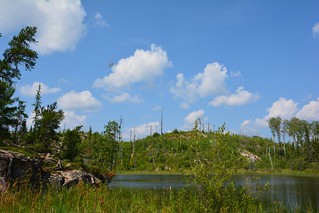






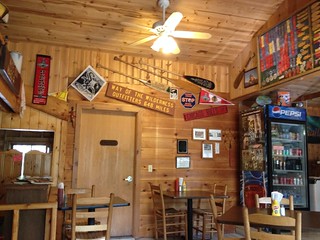
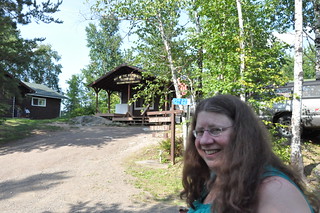
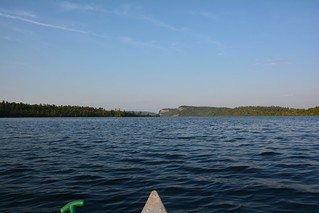

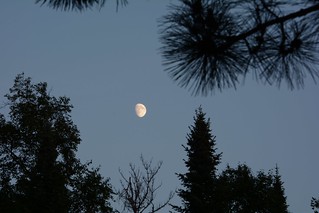
I like that dowdy Laurentian Divide sign, especially the Comic Sans-like cursive of “National Forest.” I wonder if that sign started work in 1966.
I love those National Forest signs! Here’s another, from Shawnee in southern Illinois.
And Millstone Bluff.